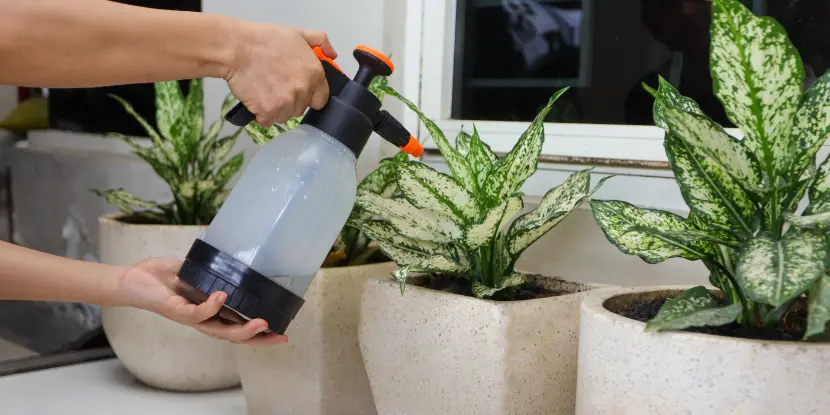Chinese evergreens, or Aglaonemas, are superb interior plants that tolerate neglect and poor conditions.
Does this mean you should neglect them?
Of course not, because a well-tended Chinese evergreen will reward you with lush foliage, occasional flowers, a calming presence, and cleaner air.
Many varieties can grow in water culture, but after extended periods, will regress and should be potted. In this blog, we’ll discuss how to get the most evergreen results.
Origins of the Chinese Evergreen
Chinese evergreens come from the tropical and subtropical rainforests of Asia and New Guinea, where they thrive under the canopy, away from direct sunlight.
Their ideal conditions mimic this natural habitat: bright, indirect light and warm temperatures. Temperatures between 65°F and 80°F (18°C and 27°C) are perfect for growth.
The term “Chinese Evergreen” reflects the plant’s geographical origins and its widespread adoption and appreciation in Chinese culture.
Chinese evergreens are renowned for their tolerance to indoor conditions. Broad leaves with striking patterns of silver, green, red, or cream bring a splash of color to an indoor space. Beyond aesthetics, they also purify the air, making them a favorite in homes and offices.
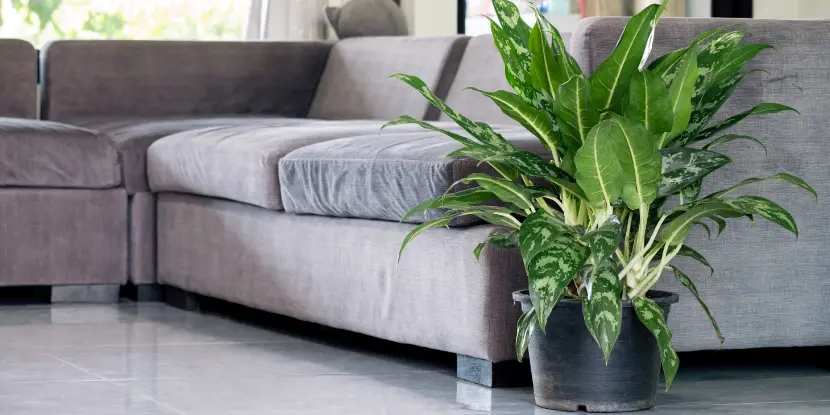
Aglaonema foliage – Spring Snow Chinese Evergreen.
Soil & Light
Soil should be well-draining yet hold enough moisture to support the plant’s needs. A mix consisting of one part peat, one part pine bark, and one part coarse sand or perlite provides an excellent balance of drainage and moisture retention. This ensures the roots are well-aerated and not sitting in water, which could lead to root rot, a common problem with poorly potted Chinese evergreens.
The plants show their best growth and leaf coloration when placed in bright, indirect light. Direct sunlight can scorch their leaves, causing damage that detracts from their beauty.
Conversely, too little light leads to leggy plants with less vibrant leaves. If you’re growing your plant in a room with inadequate natural light, consider using a grow lamp to supplement light conditions.
Watering Chinese Evergreens
Water your plant thoroughly, then wait until the top inch of the soil feels dry before watering again. Never let the soil dry completely. This balance prevents root rot, while ensuring the plant has enough moisture to support its spectacular foliage.
Misting Chinese evergreens discourages pests.
Fertilizing Chinese Evergreens
Fertilize your plant during the growing season, spanning spring through early fall. Apply a balanced, water-soluble fertilizer once a month, diluted to half the recommended strength.
During the winter months, when growth naturally slows, reduce fertilizing to once every other month or pause it altogether. This seasonal adjustment mirrors your Chinese evergreen’s natural growth cycle.
Insects & Pests
Chinese Evergreens are susceptible to a few common pests, including spider mites, mealybugs, and scale insects, which can weaken growth and damage the leaves.
- Spider mites thrive in dry conditions, and can be controlled by regularly misting your plant.
- Mealybugs look like tiny bits of cotton on the plant’s leaves. Spray your Chinese evergreen with water and dish soap to get rid of them.
- Rubbing alcohol deters mealybugs and scale insects. Dip a cotton swab in alcohol and gently dab the insects to remove them without harming the plant.
- For larger infestations, consider using a neem oil spray, a natural insecticide, which can be applied directly to the foliage and soil to eradicate these pests.
Propagating Chinese Evergreens
Plants can be propagated through stem cuttings or division during repotting. Stem cuttings should be taken from healthy, mature plants with at least two nodes (where the leaves connect to the stem) and a few leaves attached.
Place the cutting in moist potting soil and cover it with a plastic bag to create a greenhouse effect. Keep the soil evenly moist until roots develop, then remove the plastic bag and treat it as a mature plant.
Division is typically done during repotting, where you separate offshoots from the main plant, each with its own set of roots. Plant these in fresh potting soil and treat them as mature plants.
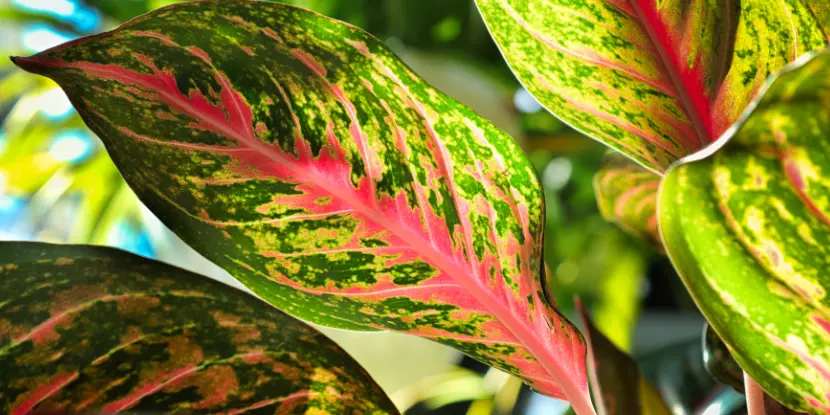
Variegated foliage of a Chinese evergreen.
Common Varieties of Chinese Evergreen
Below are some of the more popular varieties of Chinese evergreen in Southern California.
Commutatum Chinese Evergreen
- Aglaonema Commutatun
- Habitat: Philippine Islands, Ceylon
- Moderate, upright, spreader to about two feet. Leaves are usually less than 10 inches long and four inches wide. Mostly oblong-elliptic to lanceolate. Foliage is dark green with silver-gray markings along primary veins. White spathe-type blossom is followed by red berries
Roebelinni Chinese Evergreen
- Aglaonema Crispum Roebelinii
- Habitat: Philippine Islands
- Moderate upright spreader to about 18 inches. Leaves are usually 10 inches long by 5 inches wide, glossy green, and leathery, with gray-green marbling and light green along lateral veins
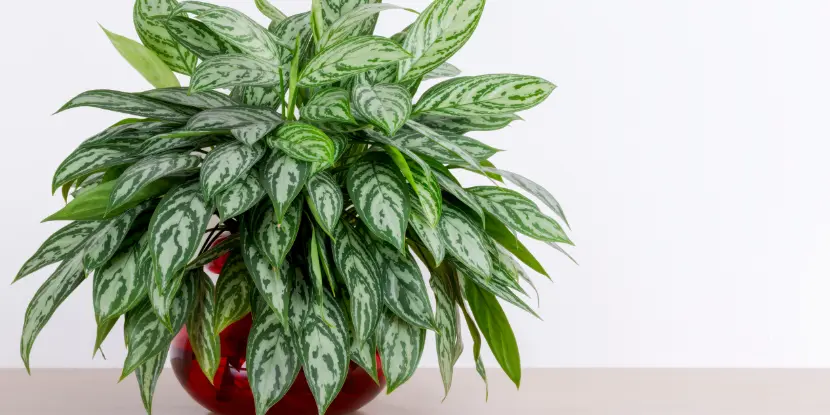
Aglaonema Maria Chinese evergreen.
Chinese Evergreen Romano, Manila Bangkok Jungle
- Aglaonema Ramano
- Habitat: Hybrid
- Silver-gray blotched foliage with dark green surroundings. Leaves are slightly rippled, giving foliage a wavy look
Silver Queen Agalonema
- Aglaonema Silver Queen
- Habitat: Hybrid
- One of the most popular Aglaonemas. Leaves are primarily silver-gray with irregular markings of dark green on the interior, often showing only a narrow edge of dark green around the leaf
White Rajah Chinese Evergreen
- Aglaonema Commutatum Pseudobracteatum
- Habitat: Hybrid
- One of the tallest Aglaonemas. May reach a height of 5 feet. Free-standing with stems bending as the plant grows. Stalks are milky white. Leaves can be 10 inches long and 4 inches wide and heavily colored from cream to gray, with outer edges
Lady Valentine Chinese Evergreen
- Aglaonema ‘Lady Valentine’
- Habitat: Hybrid
- Known for its striking foliage. Leaves are a mix of pink, green, and cream colors. Stands out due to its vibrant leaf colorations. Typically grows up to about 20 inches high
Cutlass Chinese Evergreen
- Aglaonema ‘Cutlass’
- Habitat: Hybrid
- Features a blend of light and dark green hues. Long, narrow leaves grow upward and outward, giving it a unique, spiky appearance. Grows up to 24 inches high
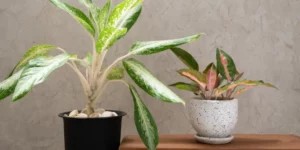
Aglaonema houseplant (Chinese Evergreen).
FAQs: Chinese Evergreen Care
Q: How often should I water my Chinese evergreen?
Water your Chinese evergreen when the top inch of the soil feels dry to the touch. Ensure the soil is moist but not waterlogged to prevent root rot.
Q: What is the best lighting condition for Chinese evergreens?
A: Plants prefer low to medium light. Direct sunlight can scorch their leaves, so placing them in a well-lit room with indirect sunlight is best.
Q: Are Chinese evergreens toxic to pets?
Chinese evergreens contain calcium oxalate crystals, which can be toxic to pets if ingested. Keep plants out of reach of your fur friends.
Q: How do I repot a Chinese evergreen?
Choose a pot that’s 1–2 inches larger in diameter than the current one. Gently remove the plant and transfer it to the new pot filled with potting soil. Water the plant after repotting. This should be done every 2-3 years or when the plant outgrows its pot.
Q: Can Chinese evergreens purify the air?
Chinese evergreens are known for their air-purifying qualities. They can remove common household toxins from the air, making your living space healthier.
Q: Why are the leaves of my Chinese evergreen turning yellow?
Yellow leaves can indicate overwatering. Allow the soil to dry slightly between waterings.
Q: How can I propagate Chinese evergreens?
They can be propagated through stem cuttings or by division during repotting. Stem cuttings should have at least two nodes and be planted in moist soil, while division involves separating offshoots from the main plant.
Q: Do Chinese evergreens need fertilizer?
Fertilize your plant with a diluted, balanced, water-soluble fertilizer once a month during the growing season, and reduce to once every other month or pause during winter.
Q: How do I deal with pests on my Chinese evergreen?
For pests like spider mites, mealybugs, and scale insects, use water and dish soap spray, dab with rubbing alcohol, or apply neem oil spray to affected areas.
Q: Can Chinese evergreens grow well in offices with artificial lighting?
Plants can thrive under fluorescent or LED office lighting, making them excellent plants for indoor spaces without natural sunlight.
Q: What’s the growth rate of Chinese evergreens?
Chinese evergreens have a moderate growth rate. They can grow a few inches each year with proper care, depending on the variety.
Q: How can I encourage more vibrant leaf colors in variegated Chinese evergreens?
Ensure your plant receives plenty of indirect sunlight. While they can survive in low-light conditions, brighter but indirect light will enhance the coloration of the leaves.


